小学外研版(三起)英语四年级上册重点知识汇总
外研版(三起)英语四年级上册全册知识点汇总复习
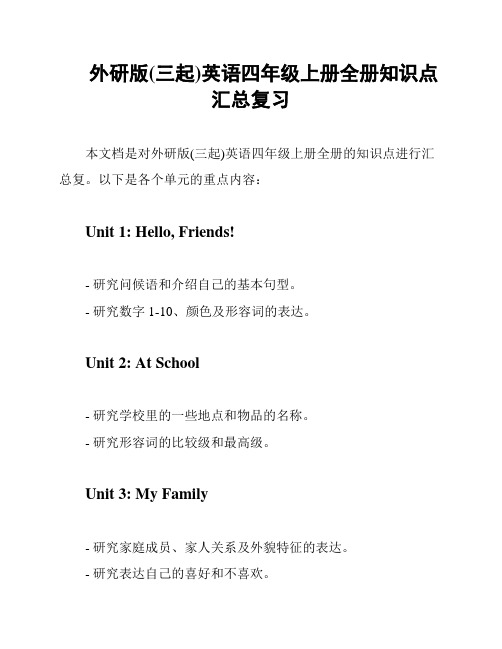
外研版(三起)英语四年级上册全册知识点汇总复习本文档是对外研版(三起)英语四年级上册全册的知识点进行汇总复。
以下是各个单元的重点内容:Unit 1: Hello, Friends!- 研究问候语和介绍自己的基本句型。
- 研究数字1-10、颜色及形容词的表达。
Unit 2: At School- 研究学校里的一些地点和物品的名称。
- 研究形容词的比较级和最高级。
Unit 3: My Family- 研究家庭成员、家人关系及外貌特征的表达。
- 研究表达自己的喜好和不喜欢。
Unit 4: My Toys- 研究玩具的名称和描述。
- 研究表达自己的玩具喜好和向别人询问玩具喜好。
Unit 5: Food and Drinks- 研究食物和饮料的名称。
- 研究表达自己的饮食喜好和向别人询问饮食喜好。
Unit 6: The Weather- 研究天气的表达和描述。
- 研究问询天气情况和回答天气的句型。
Unit 7: Clothes- 研究衣服的名称和描述。
- 研究表达自己的衣着喜好和向别人询问衣着喜好。
Unit 8: Sports- 研究体育运动的名称。
- 研究表达自己的体育爱好和询问别人的体育爱好。
Unit 9: At the Farm- 研究农场动物的名称和描述。
- 研究表达自己对动物的喜好和向别人询问对动物的喜好。
Unit 10: At the Zoo- 研究动物园里的动物名称。
- 研究表达自己对动物的描述和向别人询问动物的特点。
以上是外研版(三起)英语四年级上册全册的知识点汇总复习。
希望对你的学习有所帮助!。
新外研版(三起)英语四年级上册全册知识点归纳
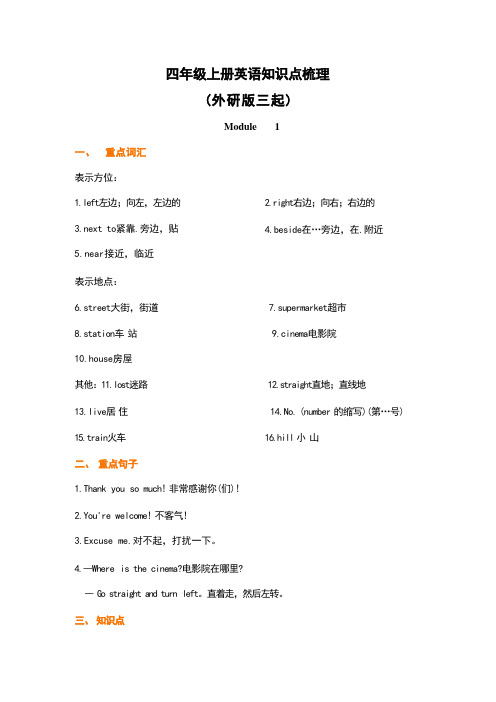
四年级上册英语知识点梳理(外研版三起)Module1一、重点词汇表示方位:1.left左边;向左,左边的2.right右边;向右;右边的3.next to紧靠.旁边,贴4.beside在…旁边,在.附近5.near接近,临近表示地点:6.street大街,街道7.supermarket超市8.station车站 9.cinema电影院10.house房屋其他:11.lost迷路 12.straight直地;直线地13.live居住14.No. (number 的缩写)(第…号)15.train火车 16.hill 小山二、重点句子1.Thank you so much! 非常感谢你(们)!2.You're welcome! 不客气!3.Excuse me.对不起,打扰一下。
4.--Where is the cinema?电影院在哪里?-- Go straight and turn left。
直着走,然后左转。
三、知识点习惯搭配live at住在No.2Park Street公园街2号go straight on直着走at the station在车站turn left / right向左/右转beside the cinema在电影院旁边all day/ night整日/夜so much十分,非常句子结构询问某人/物的位置-- Where is …?--I t's+其他eg:1.-- Where is the library?-- It's near the park.2.--Where is the cinema?-- Go straight and turn left3.-- Where is my book?-- It's on the desk.Module2一、重点词汇动词:read(读,阅读) take(拍摄)listen( 听) talk(说话,交谈)名词:picture(照片) children(孩子们)(child 的复数形式) China(中国)其他:running(跑步) these(这些)二、重点句子1.Look at these pictures. 看这些照片。
外研版(三起)英语四年级上册重点知识汇总
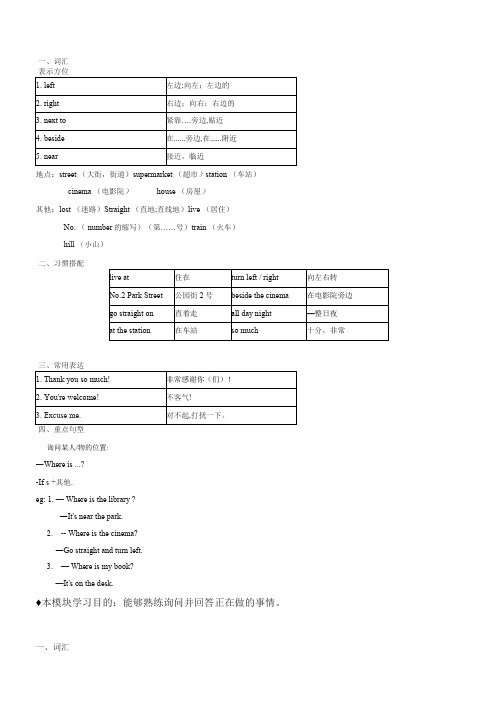
一、词汇其他:lost (迷路)Straight (直地;直线地)live (居住)No. ( number的缩写)(第……号)train (火车)hill (小山)二、习惯搭配询问某人/物的位置:―Where is ...?-If s +其他.eg: 1. — Where is the library ?―It's near the park.2.-- Where is the cinema?―Go straight and turn left.3.— Where is my book?—It's on the desk.♦本模块学习目的:能够熟练询问并回答正在做的事情。
一、词汇动词:read (读,阅读)take (拍摄)listen (听)talk (说话,交谈)名词:picture (照片)children (孩子<门)(child的复数形式)China (中国)其他:running (跑步)these (这些)二、习惯搭配三、重点句型1.描述某人正在做某事主语+ be动词(is / am are ) +动词・ing +其他eg: 1.1 am watching TV.2.She is playing baseball.3.They are having a Chinese class.2.询问某人正在做什么:—What + be 动词(is / are ) + 主语+ doing?—主语+ be动词(is / am are ) +动词・ing +其他eg: 1. —What are you doing?—I'm listening to music.2.—What is Jack doing?—He is doing his homework.9.men (man的复数开,式)男人10.between 在....之间,在中间Me too. 我也一样。
四、重点句型1.-What are they doing?-They are +动词-ing形式(+其他).eg: -What are they doing?-They are listening to music.2.-What is +主语(第三人称单数)+ doing?-主语(第三人称单数)+ is +动词-ing形式(+其他). eg: -What's the elephant doing?三、惯用表达1.Yes. please. 是的,麻烦了。
外研版英语三年级起点四年级上册

外研版英语三年级起点四年级上册一、单词部分。
1. Module 1.- 单词汇总。
- straight [streɪt] 直地,直线地。
- left [left] 左边;向左;左边的。
- right [raɪt] 右边;向右;右边的。
- lost [lɒst] 迷路的。
- live [lɪv] 居住。
- No. (number的缩写)第……号。
- street [striːt] 大街,街道。
- excuse me对不起,打扰。
- turn left向左转。
- turn right向右转。
- next to紧靠……旁边,贴近。
- supermarket ['suːpəmɑːkɪt] 超市。
- beside [bɪ'saɪd] 在……旁边,在……附近。
- cinema ['sɪnəmə] 电影院。
- 重点单词用法。
- “left”和“right”:这两个单词既可以作名词表示方向(左边、右边),也可以作形容词(左边的、右边的)和副词(向左、向右)。
例如:Turn left at the second crossing.(在第二个十字路口向左转。
)The book is on my right hand.(书在我的右手边。
)- “live”:是不及物动词,后面常接表示地点的介词短语。
例如:I live in Beijing.(我住在北京。
)2. Module 2.- 单词汇总。
- read [riːd] 阅读。
- running [ˈrʌnɪŋ] 跑步。
- these [ðiːz] 这些。
- picture ['pɪktʃə(r)] 图画。
- take [teɪk] 拍摄。
- children ['tʃɪldrən] (child的复数形式) 孩子们。
- listen ['lɪsn] 听。
- talk [tɔːk] 说话,交谈。
- China ['tʃaɪnə] 中国。
外研版三年级起点四年级上册知识点
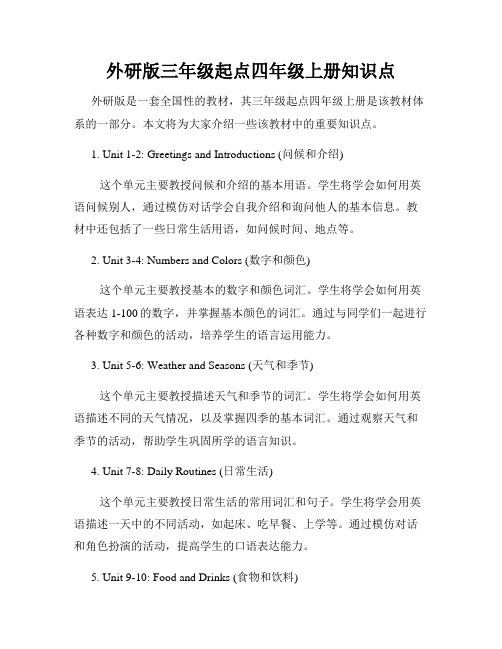
外研版三年级起点四年级上册知识点外研版是一套全国性的教材,其三年级起点四年级上册是该教材体系的一部分。
本文将为大家介绍一些该教材中的重要知识点。
1. Unit 1-2: Greetings and Introductions (问候和介绍)这个单元主要教授问候和介绍的基本用语。
学生将学会如何用英语问候别人,通过模仿对话学会自我介绍和询问他人的基本信息。
教材中还包括了一些日常生活用语,如问候时间、地点等。
2. Unit 3-4: Numbers and Colors (数字和颜色)这个单元主要教授基本的数字和颜色词汇。
学生将学会如何用英语表达1-100的数字,并掌握基本颜色的词汇。
通过与同学们一起进行各种数字和颜色的活动,培养学生的语言运用能力。
3. Unit 5-6: Weather and Seasons (天气和季节)这个单元主要教授描述天气和季节的词汇。
学生将学会如何用英语描述不同的天气情况,以及掌握四季的基本词汇。
通过观察天气和季节的活动,帮助学生巩固所学的语言知识。
4. Unit 7-8: Daily Routines (日常生活)这个单元主要教授日常生活的常用词汇和句子。
学生将学会用英语描述一天中的不同活动,如起床、吃早餐、上学等。
通过模仿对话和角色扮演的活动,提高学生的口语表达能力。
5. Unit 9-10: Food and Drinks (食物和饮料)这个单元主要教授与食物和饮料相关的词汇。
学生将学会用英语表达各种食物和饮料的名称,并了解一些与健康饮食相关的知识。
通过制作简单的食物和饮料,培养学生的动手能力和创造力。
6. Unit 11-12: Animals and Body Parts (动物和身体部位)这个单元主要教授与动物和身体部位相关的词汇。
学生将学会用英语描述不同的动物和身体部位,并通过观察和模仿动物的活动,了解动物的一些基本特征。
通过绘画和手工制作动物,激发学生的创造力。
外研三起英语四年级上册
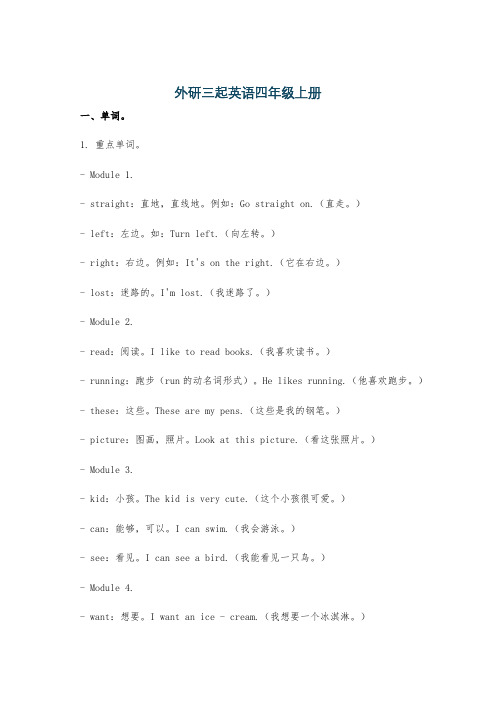
外研三起英语四年级上册一、单词。
1. 重点单词。
- Module 1.- straight:直地,直线地。
例如:Go straight on.(直走。
)- left:左边。
如:Turn left.(向左转。
)- right:右边。
例如:It's on the right.(它在右边。
)- lost:迷路的。
I'm lost.(我迷路了。
)- Module 2.- read:阅读。
I like to read books.(我喜欢读书。
)- running:跑步(run的动名词形式)。
He likes running.(他喜欢跑步。
)- these:这些。
These are my pens.(这些是我的钢笔。
)- picture:图画,照片。
Look at this picture.(看这张照片。
)- Module 3.- kid:小孩。
The kid is very cute.(这个小孩很可爱。
)- can:能够,可以。
I can swim.(我会游泳。
)- see:看见。
I can see a bird.(我能看见一只鸟。
)- Module 4.- want:想要。
I want an ice - cream.(我想要一个冰淇淋。
)- juice:果汁。
I like orange juice.(我喜欢橙汁。
)- ice:冰,冰块。
There is some ice in the glass.(杯子里有一些冰。
)- also:也,还。
I like apples, and I also like bananas.(我喜欢苹果,我也喜欢香蕉。
)- Module 5.- noodles:面条。
I have noodles for lunch.(我午餐吃面条。
)- rice:米饭。
Rice is very important in Asian countries.(米饭在亚洲国家很重要。
)- fish:鱼,鱼肉。
外研版(三起)英语四年级上册全册知识点汇总复习
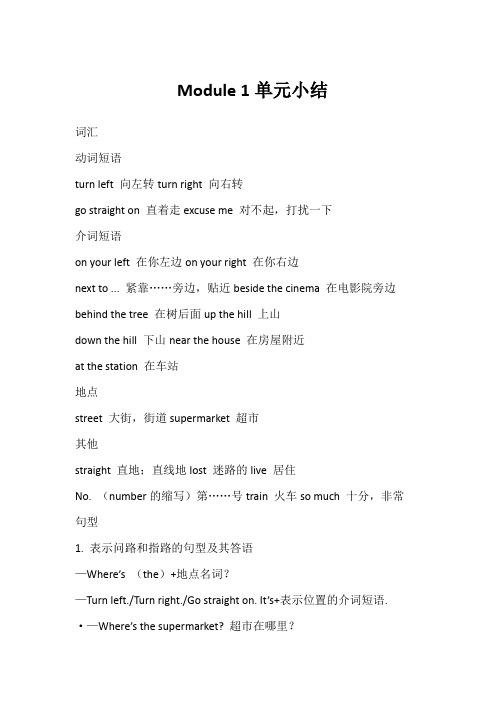
Module 1单元小结词汇动词短语turn left 向左转turn right 向右转go straight on 直着走excuse me 对不起,打扰一下介词短语on your left 在你左边on your right 在你右边next to ... 紧靠……旁边,贴近beside the cinema 在电影院旁边behind the tree 在树后面up the hill 上山down the hill 下山near the house 在房屋附近at the station 在车站地点street 大街,街道supermarket 超市其他straight 直地;直线地lost 迷路的live 居住No. (number的缩写)第……号train 火车so much 十分,非常句型1. 表示问路和指路的句型及其答语—Where’s (the)+地点名词?—Turn left./Turn right./Go straight on. It’s+表示位置的介词短语. ·—Where’s the supermarket? 超市在哪里?—Go straight on. Turn right. It’s near the park. 直着走。
向右转。
它在公园附近。
2. 常用感谢语的答语You’re welcome! 不客气!Module 2 单元小结词汇动作read a book 读书play football 踢足球play basketball 打篮球take pictures 照相watch TV 看电视fly a kite 放风筝listen to music 听音乐ride a bike 骑自行车play with 玩……talk to 和……交谈指示代词this 这个that 那个these 这些those 那些其他children (child的复数形式)孩子们China 中国running 跑步句型询问对方正在干什么的句型及其答语—What are you doing?—I’m+动词-ing形式+其他.·—What are you doing? 你正在做什么?—I’m listening to music. 我正在听音乐。
外研版(三起)四年级英语上册全册知识点汇总复习
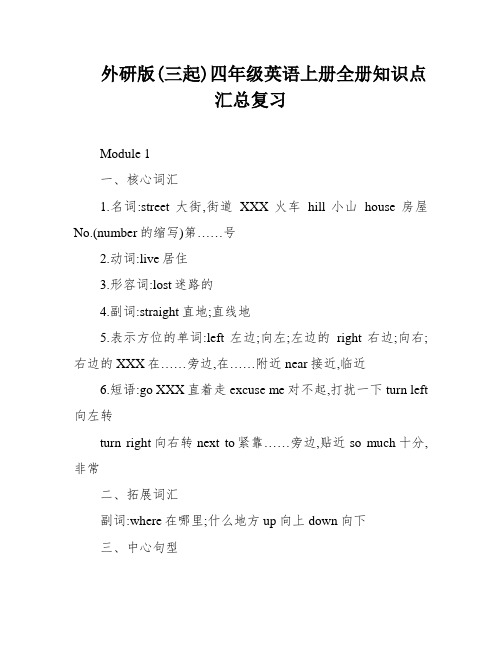
外研版(三起)四年级英语上册全册知识点汇总复习Module 1一、核心词汇1.名词:street大街,街道XXX火车hill小山house房屋No.(number的缩写)第……号2.动词:live居住3.形容词:lost迷路的4.副词:straight直地;直线地5.表示方位的单词:left左边;向左;左边的right右边;向右;右边的XXX在……旁边,在……附近near接近,临近6.短语:go XXX直着走excuse me对不起,打扰一下turn left 向左转turn right向右转next to紧靠……旁边,贴近so much十分,非常二、拓展词汇副词:where在哪里;什么地方up向上down向下三、中心句型1. Where s No. 2 Park Street, please?请问公园街2号在哪里?解读:此句是用来讯问某地在哪里的句型。
where指导的特殊疑问句通常用来讯问“……在哪里”。
当句中透露表现地址的名词是单数时, be动词用is;当透露表现地址的名词是复数时, be动词用are。
举一反三:XXX?宾馆在哪里?Where is your home?你家在哪里?拓展:where还可用来讯问或人来自哪里。
Where are they from?他们来自哪里?Where is he from?他来自哪里?2. XXX left.向左转。
Go XXX.直着走。
XXX right.向右转。
解读:这三个句子都是祈使句。
用来透露表现恳求、命令、劝说、建议等的句子叫作祈使句。
在祈使句中,因为说话的双方都晓得说话的具体情景,以是常省略主语。
举一反三:XXX right and then go XXX.向右转,然后直着走。
Be careful!小心!拓展:祈使句有肯定形式和否定形式两种形式。
(1)肯定形式的祈使句。
Keep quiet, please.请保持安静。
(2)否定形式的祈使句。
Don t be late.不要早退。
全]外研版(三起)小学英语四年级上册知识点归纳总结
![全]外研版(三起)小学英语四年级上册知识点归纳总结](https://img.taocdn.com/s3/m/425c03e86e1aff00bed5b9f3f90f76c661374cd0.png)
全]外研版(三起)小学英语四年级上册知识点归纳总结Module 1:In Module 1.we learn about words that express n and n。
such as "left," "right," "next to," "beside," and "near." We also learn some common places。
like "street," "supermarket," "n," "cinema," and "house." nally。
we learn about the phrase "live at," the use of "turn left/right," and the n "thank you so much." The key sentence structure we learn is "Where is。
" followed by "It's + n."Module 2:In Module 2.we learn about verbs like "read," "take," "listen," and "talk," as well as the noun "picture" and the plural form of "child." We also learn about the phrase "take pictures," and common activities like "play with," "listen to," "look at," "talk to," "read a book," "play football," and "watch TV." There are no new XXX.XXX's Day OutMary is a young girl who is having a fun day out with her family。
外研版(三起)英语四年级上册全册知识点汇总复习
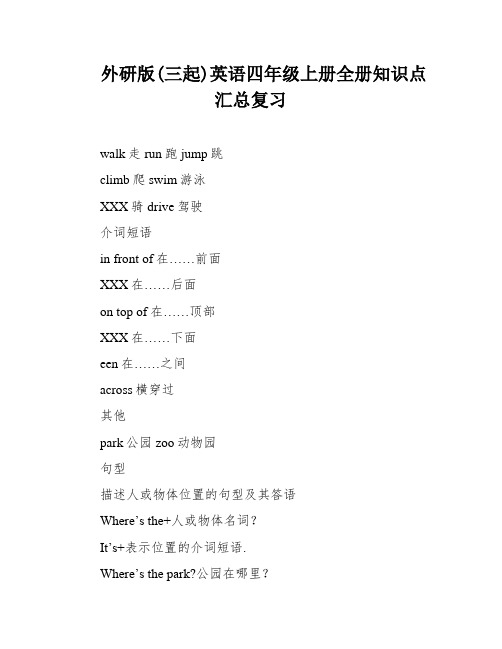
外研版(三起)英语四年级上册全册知识点汇总复习walk走run跑jump跳climb爬swim游泳XXX骑drive驾驶介词短语in front of在……前面XXX在……后面on top of在……顶部XXX在……下面een在……之间across横穿过其他park公园zoo动物园句型描述人或物体位置的句型及其答语Where’s the+人或物体名词?It’s+表示位置的介词短语.Where’s the park?公园在哪里?It’s across the street.它横穿过这条街。
描述人或物体位置的句型也可以用于询问和描述方向。
例如:Where’s the post office?邮局在哪里?Go straight on。
It’s on your left.直着走。
它在你的左边。
Get on the bus。
do taijiquan。
row a dragon boat。
play chess。
drink soya milk。
play football。
draw pictures。
see。
jump。
dance。
and sing。
These are all fun activities that people can do in the park。
on the lake。
or een the trees.Kids。
people。
and men can all enjoy these activities。
They can ride the boat。
watch the clock。
or just enjoy the XXX。
When they get hungry。
they can have some fast food。
a tomato。
an egg。
or a potato。
They can also have some juice or dumplings.If someone wants something。
四年级上册英语外研版三年级起点

四年级上册英语外研版三年级起点一、单词部分。
1. Module 1.- 单词:- straight:直地,直线地。
例如:Go straight on.(直走。
)- left:左边。
如:Turn left.(向左转)- right:右边。
例如:Turn right.(向右转)- lost:迷路的。
例如:I'm lost.(我迷路了。
)- live:居住。
例如:I live in Beijing.(我住在北京。
)- No. (number的缩写):第……号。
例如:No. 2 Park Street.(公园街2号。
)- street:街道。
如:This is a busy street.(这是一条繁忙的街道。
)- excuse me:对不起,打扰一下。
这是一个常用的礼貌用语,用于引起他人注意或请求帮助。
例如:Excuse me, where is the library?(打扰一下,图书馆在哪里?)- turn left/right:向左/右转。
这是指路或描述行走方向时常用的短语。
- 重点句型:- Where are you? 你在哪里?- I'm behind the tree. 我在树后面。
- Where's the school? 学校在哪里?- It's next to the park. 它在公园旁边。
2. Module 2.- 单词:- read:阅读。
例如:I like to read books.(我喜欢读书。
)- running:跑步(run的动名词形式)。
例如:I like running.(我喜欢跑步。
)- these:这些。
例如:These are my books.(这些是我的书。
)- picture:图画。
例如:This is a beautiful picture.(这是一幅美丽的图画。
)- take:拍摄。
例如:Take a picture.(拍张照片。
最全外研版(三起)小学英语四年级上册知识点复习归纳总结

最全外研版(三起)小学英语四年级上册知识点复习归纳总结外研(三起)四年级上册Module 11.单词straight直地go straight on直着走left 左边lost迷路的live居住No.第……号street大街excuse me对不起,打扰turn left向左转turn right向右转next to... 临近的supermarket超市beside在……旁边cinema电影院so much十分,非常You're welcome!不客气!station车站train火车hill小山near接近,临近house房屋2.短语1)excuse me 打扰一下2)turn left 向左转3)turn right 向右转4)go straight on 直着走5)up the hill 上山6)down the hill 下山7)near the house 在房子附近3.句子(1)A: Excuse me. Where’s No.2 Park Street, please? 打扰了,请问第二公园大街在哪里?B: Go straight on and turn left. 直着走然后向左转。
(2)A: Thank you so much. 十分感谢你。
B: You are welcome. 不用谢。
(3)It’s near the house. 它在房屋附近。
(4)It’s on your left. 它在你的左边。
(5)It’s behind the cinema. 它在电影院后面。
外研(三起)四年级上册Module 21.单词read阅读running跑步these这些picture图画take拍摄take pictures照相children孩子们listen听listen to听talk说话,交谈talk to和……交谈China中国read—reading take—taking talk—talking play—playing look—looking run—running 2.短语1)read a book 读书2)take pictures 拍照3)watch TV 看电视4)play with a toy train 玩玩具火车5)ride a bike 骑自行车6)fly a kite 放风筝7)listen tomusic 听音乐8)talk tomy friend 和朋友交谈3.句子(1)This is my friend Maomao. 这是我的朋友毛毛。
三年级起点外研版英语四年级上册

三年级起点外研版英语四年级上册一、单词。
1. Module 1.- 直的:straight。
- 直地;直线地:straight。
- 左边;向左;左边的:left。
- 右边;向右;右边的:right。
- 迷路的:lost。
- 居住:live。
- 号;号码:number。
- 大街,街道:street。
- 对不起,打扰一下:excuse me。
- 转弯,转向:turn。
- 电影院:cinema。
- 车站:station。
- 超市:supermarket。
- 在……附近:near。
- 房屋,房子,住宅:house。
2. Module 2.- 读;阅读:read。
- 跑步:run。
- 这些:these。
- 照片:picture。
- 拍照:take。
- 孩子:child(复数:children)- 听:listen。
- 听音乐:listen to music。
- 谈话;说话:talk。
- 与……交谈:talk to。
3. Module 3.- 小孩:kid。
- 得到:get。
- 我们(宾格):us。
- 下(车、船等):get off。
- 能够;会:can。
- 看到:see。
- 许多:lots of。
- 有趣的事:interest。
- 东西;物品;事情:thing。
- 人,人们:people。
- 划(船):row。
- 龙:dragon。
- 龙舟:dragon boat。
- 男人(复数):men。
- 在……之间:between。
- 在……之上:above。
- 在……下面:below。
- 在……旁边:beside。
4. Module 4.- 想要;需要:want。
- 一些;任何:some。
- 果汁:juice。
- 冰;冰块:ice。
- 也;还:too。
- 食物:food。
- 快餐:fast food。
- 制作;做:make。
- 番茄;西红柿:tomato(复数:tomatoes)- 鸡蛋:egg。
- 马铃薯;土豆:potato(复数:potatoes)- 花:flower。
最新外研版三年级起点四年级上册知识点总结(最新最全)
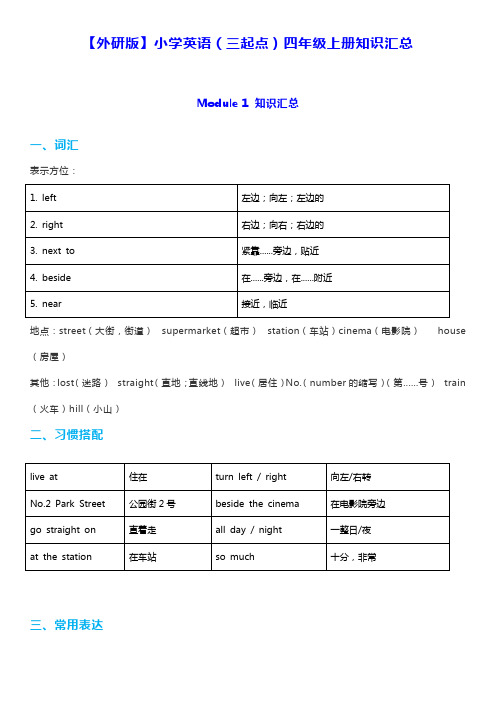
【外研版】小学英语(三起点)四年级上册知识汇总Module 1 知识汇总一、词汇表示方位:地点:street(大街,街道) supermarket(超市) station(车站)cinema(电影院) house (房屋)其他:lost(迷路) straight(直地;直线地) live(居住)No.(number的缩写)(第......号) train (火车)hill(小山)二、习惯搭配三、常用表达四、重点句型询问某人/物的位置:-- Where is ...?-- It’s + 其他.eg: 1. -- Where is the library? -- It’s near the park.2. -- Where is the cinema? -- Go straight and turn left.3. -- Where is my book?-- It’s on the desk.Module 2 知识汇总本模块学习目的:能够熟练询问并回答正在做的事情。
一、词汇动词:read(读,阅读) take(拍摄) listen(听)talk(说话,交谈)名词:picture(照片) children(孩子们)(child的复数形式)China(中国)其他:running(跑步) these(这些)二、习惯搭配三、重点句型1. 描述某人正在做某事:主语+ be动词(is / am / are)+ 动词-ing + 其他.eg: 1. I am watching TV.2. She is playing baseball.3. They are having a Chinese class.2. 询问某人正在做什么:-What + be动词(is / are)+ 主语+ doing?-主语+ be动词(is / am / are)+ 动词-ing + 其他.eg: 1. -What are you doing?-I’m listening to music.2. -What is Jack doing?-He is doing his homework.Module 3 知识汇总一、词汇1. kid 小孩2. can 能够,会3. see 看到4. interesting 有趣的5. thing 东西,物品;事情6. people 人,人们7. row 划(船) 8. dragon 龙9. men (man的复数形式)男人10. between 在……之间,在中间11. chess 国际象棋 12. drink 喝,饮13. clock 钟 14. hungry 饥饿的15. draw 画 16. jump 跳17. sing 唱歌 18. dance 跳舞二、习惯搭配三、惯用表达Me too. 我也一样。
三起点外研版新标准英语四年级上册期末考试重难点知识点复习及练习
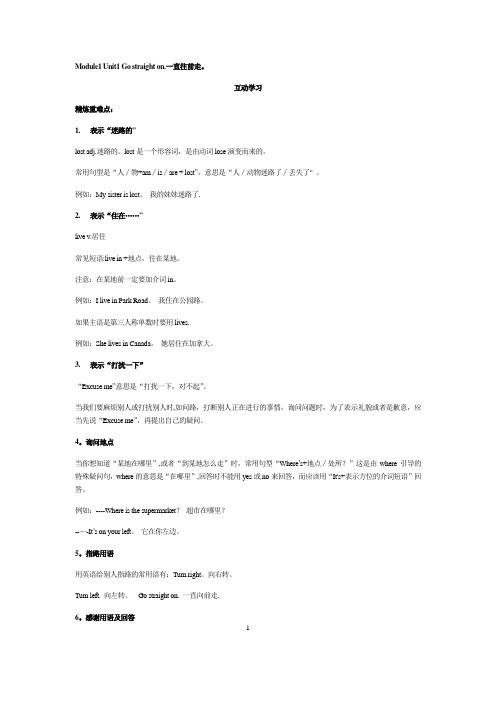
Module1 Unit1 Go straight on.一直往前走。
互动学习精炼重难点:1.表示“迷路的"lost adj.迷路的。
lost是一个形容词,是由动词lose演变而来的。
常用句型是“人∕物+am∕is∕are + lost”,意思是“人∕动物迷路了∕丢失了" 。
例如:My sister is lost。
我的妹妹迷路了.2.表示“住在……"live v.居住常见短语:live in +地点,住在某地。
注意:在某地前一定要加介词in。
例如:I live in Park Road。
我住在公园路。
如果主语是第三人称单数时要用lives.例如:She lives in Canada。
她居住在加拿大。
3.表示“打扰一下”“Excuse me”意思是“打扰一下,对不起”。
当我们要麻烦别人或打扰别人时,如问路,打断别人正在进行的事情,询问问题时,为了表示礼貌或者是歉意,应当先说“Excuse me”,再提出自己的疑问。
4。
询问地点当你想知道“某地在哪里”,或者“到某地怎么走”时,常用句型“Where’s+地点∕处所?”这是由where引导的特殊疑问句,where的意思是“在哪里”,回答时不能用yes或no来回答,而应该用“It's+表示方位的介词短语”回答。
例如:----Where is the supermarket?超市在哪里?--—-It’s on your left。
它在你左边。
5。
指路用语用英语给别人指路的常用语有:Turn right。
向右转。
Turn left. 向左转。
Go straight on. 一直向前走.6。
感谢用语及回答1Thank you。
谢谢你.为感谢用语。
当他人帮助了自己或夸奖、赞美自己时,我们要说“Thank you”来表示感谢。
其回答为:Y ou’re welcome。
不用谢。
Module2词汇:精炼重难点:1.表示“看……”look 表示“看"的这个动作,是不及物动词。
小学英语四年级上册课本知识点(外研版三年级起点)
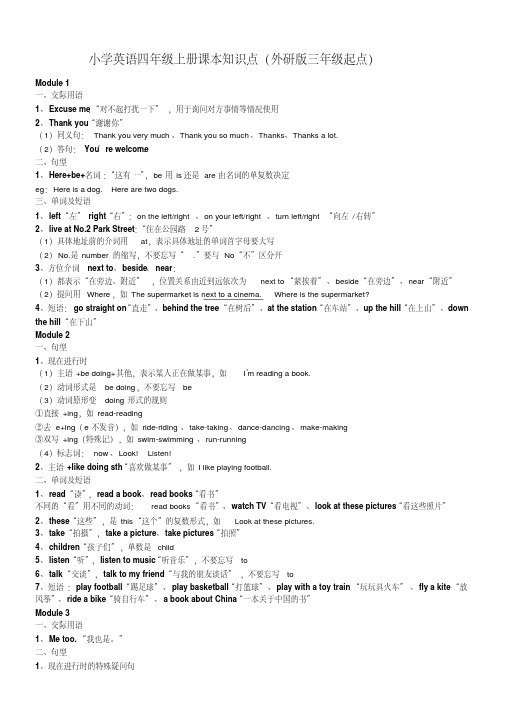
小学英语四年级上册课本知识点(外研版三年级起点)Module 1一、交际用语1、Excuse me:“对不起打扰一下”,用于询问对方事情等情况使用2、Thank you“谢谢你”(1)同义句:Thank you very much、Thank you so much、Thanks、Thanks a lot.(2)答句:You’re welcome.二、句型1、Here+be+名词:“这有…”,be用is还是are由名词的单复数决定eg:Here is a dog. Here are two dogs.三、单词及短语1、left“左”right“右”:on the left/right、on your left/right、turn left/right“向左/右转”2、live at No.2 Park Street:“住在公园路2号”(1)具体地址前的介词用at,表示具体地址的单词首字母要大写(2)No.是number的缩写,不要忘写“.”要与No“不”区分开3、方位介词next to、beside、near:(1)都表示“在旁边、附近”,位置关系由近到远依次为next to“紧挨着”、beside“在旁边”、near“附近”(2)提问用Where,如The supermarket is next to a cinema. Where is the supermarket?4、短语:go straight on“直走”、behind the tree“在树后”、at the station“在车站”、up the hill“在上山”、down the hill“在下山”Module 2一、句型1、现在进行时(1)主语+be doing+其他,表示某人正在做某事,如I’m reading a book.(2)动词形式是be doing,不要忘写be(3)动词原形变doing形式的规则①直接+ing,如read-reading②去e+ing(e不发音),如ride-riding、take-taking、dance-dancing、make-making③双写+ing(特殊记),如swim-swimming、run-running(4)标志词:now、Look! Listen!2、主语+like doing sth“喜欢做某事”,如I like playing football.二、单词及短语1、read“读”,read a book、read books“看书”不同的“看”用不同的动词:read books“看书”、watch TV“看电视”、look at these pictures“看这些照片”2、these“这些”,是this“这个”的复数形式,如Look at these pictures.3、take“拍摄”,take a picture、take pictures“拍照”4、children“孩子们”,单数是child5、listen“听”,listen to music“听音乐”,不要忘写to6、talk“交谈”,talk to my friend“与我的朋友谈话”,不要忘写to7、短语:play football“踢足球”、play basketball“打篮球”、play with a toy train“玩玩具火车”、fly a kite“放风筝”、ride a bike“骑自行车”、a book about China“一本关于中国的书”Module 3一、交际用语1、Me too.“我也是。
- 1、下载文档前请自行甄别文档内容的完整性,平台不提供额外的编辑、内容补充、找答案等附加服务。
- 2、"仅部分预览"的文档,不可在线预览部分如存在完整性等问题,可反馈申请退款(可完整预览的文档不适用该条件!)。
- 3、如文档侵犯您的权益,请联系客服反馈,我们会尽快为您处理(人工客服工作时间:9:00-18:30)。
一、词汇
其他:lost (迷路)Straight (直地;直线地)live (居住)
No. ( number的缩写)(第……号)train (火车)
hill (小山)
二、习惯搭配
询问某人/物的位置:
―Where is ...?
-If s +其他.
eg: 1. — Where is the library ?
―It's near the park.
2.-- Where is the cinema?
―Go straight and turn left.
3.— Where is my book?
—It's on the desk.
♦本模块学习目的:能够熟练询问并回答正在做的事情。
一、词汇
动词:read (读,阅读)take (拍摄)listen (听)
talk (说话,交谈)
名词:picture (照片)children (孩子<门)(child的复数形式)China (中国)其他:running (跑步)these (这些)
二、习惯搭配
三、重点句型
1.描述某人正在做某事
主语+ be动词(is / am are ) +动词・ing +其他eg: 1.1 am watching TV.
2.She is playing baseball.
3.They are having a Chinese class.
2.询问某人正在做什么:
—What + be 动词(is / are ) + 主语+ doing?
—主语+ be动词(is / am are ) +动词・ing +其他
eg: 1. —What are you doing?
—I'm listening to music.
2.—What is Jack doing?
—He is doing his homework.。
